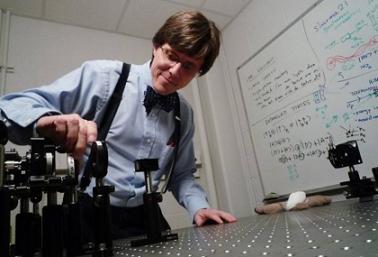所谓的随机码(random numbers),其实通常并非是真正的随机,因为用以生成真正随机乱码的方法很罕见、计算速度也很慢;也因为如此,大多数需要乱码的应用,只能凑合着使用“伪随机码”。美国伊利诺大学(University of Illinois)的研究人员表示,他们已经打造出一种能够产生真正随机码的算法,而且运行速度很快。
“我们的量子技术能提供安全的随机码产生方法,而且是以高速度;”伊利诺大学教授Paul Kwiat表示,他们所研究出的方法比目前各种随机码产生法快上十倍。新方法是将激光二极管所产生的光脉冲(optical pulses)形塑,然后将随机光子抵达探测器的时距数字化;该种方法目前不仅能够调节至100Mbps的运行速度,也有潜力透过激光驱动器电路与探测器的改善,让速度再提升至10Gbps的水平。

一个更好的随机码就此产生:伊利诺大学物理和电子计算机工程学院教授Paul Kwiat在实验室。
Kwiat与电子电机在读博士Michael Wayne一同进行以上研究,他表示,新算法能适合多种应用,包括数据加密、统计分析以及高阶的数值模拟(numerical simulations)等。目前这类应用大多得依赖“伪随机(pseudo-random)”方法,也就是一个实体系统的确定性计算(deterministic calculations),通常以一个是作为“种子”的初始值(starting value)为基础。
伪随机码的产生速度能跟新方法一样快,但是只能产生在计算性上很难去预测的数字;而量子技术虽能制造真正的随机码,却通常因为仰赖运作缓慢的单光子探测器,使得速度太慢。新发明的方法则是结合了两者之长,速度既快、也能保证所产生数字的随机性。
点击下一页查看:参考原文:Quantum method generates faster random numbers
{pagination}
Quantum method generates faster random numbers
by R. Colin Johnson
Random numbers are usually not really random, since the methods by which a truly random number can be generated are few, far between and very slow to calculate. As a result, most applications in need of random numbers have to make do with pseudo-random numbers. Now researchers at the University of Illinois claim to have crafted a truly random number generation algorithm that is fast to execute.
"Our quantum method provides fast, secure random number generation at very high speeds," said professor Paul Kwiat. "Our method is 10-times faster than any other quantum random number generator reported so far."
The new method is based on shaping the optical pulses from a laser diode and then digitizing the time interval between random photon arrivals at a detector. Based on quantum mechanics, which insures that the measured interval is truly random, the method can nevertheless be tuned to execute as fast as 100 Mbits per second today, with the potential to achieve 10 Gbits per second with planned improvements to its laser driver circuit and detector.
Kwiat, who performed the work with EE doctoral candidate Michael Wayne, said the new algorithm is compatible with a variety of applications, including data encryption, statistical analysis, and advanced numerical simulations.
Today these applications have to depend on pseudo-random methods based on deterministic calculations of a physical system, usually based on a "seed" starting value. Pseudo-random numbers can be generated as fast as the new method, but only produce numbers that are too computationally difficult to predict. Quantum methods, on the other hand, create truly random numbers, but are usually too slow since they rely on slow-operating single-photon detectors. But the new method combines the best of both worlds--high speed and guaranteed randomness.